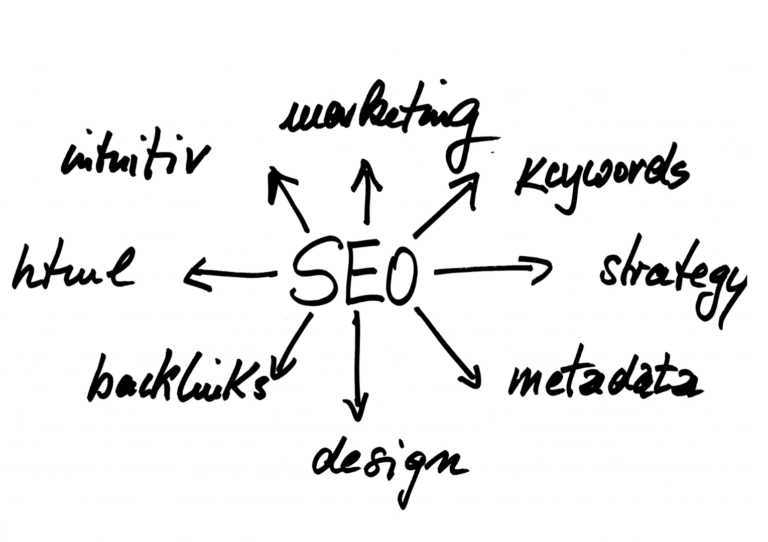
What is SEM, SEO, PPC and CRO, and why does it matter?
Several acronyms have appeared in web design terminology in recent years. If we do not know their basic meanings, we can easily get lost in capital letters and insufficiently transparent definitions. You probably see these acronyms regularly. At the beginning, it is important to note that SEM, SEO, PPC and CRO have a common goal: to achieve the desired visibility on the web and increase traffic to your site. In the acronyms SEM AND SEO, S stands for Search, which directly directs us to the visibility of websites on search engines and social networks, and the quality of web search. Let’s take a quick look at these acronyms, so that we can usefully inform you about their meaning and importance, and at the same time set some basic definitions behind these acronyms.
SEM
SEM (Search Engine Marketing) is an umbrella term that takes into account techniques to improve the visibility of entities, sites, companies or people on search engines. Therefore, SEM is a combination of marketing techniques combined with search engine ranking issues, not marketing techniques per se. SEM, therefore, includes SEO (Search Engine Optimization), PPC (Pay Per Click) and SMO (Social Media Optimization) and all other search engine optimization techniques, as well as conditions for the visibility of its content on social networks.
The purpose of an SEO campaign is to optimize the content of the site using different keywords, which improves its visibility on search engines. The goal is to achieve the highest possible ranking in organic search engine results. Significant benefits here may be slow, but long-term high visibility of organic search is the most effective and cheapest means of advertising. A good SEO campaign will not only optimize your content with keywords, but will also include analysis of search trends and see if there are low-competitive keywords on the site that can be replaced with significantly more competitive words.
SEO
SEO (Search Engine Optimization) is a set of techniques whose common goal is to ensure the visibility of your website. Generally speaking, “content is king”, which means that the marketing of your website should be based on strong content. Good content is often not enough, but you can optimize it to “trick” search engine algorithms such as Google, Yahoo, Bing, etc.
The purpose of an SEO campaign is to optimize the content of the site using different keywords, which improves its visibility on search engines. The goal is to achieve the highest possible ranking in organic search engine results. Significant benefits here may be slow, but long-term high visibility of organic search is the most effective and cheapest means of advertising. A good SEO campaign will not only optimize your content with keywords, but will also include analysis of search trends and see if there are low-competitive keywords on the site that can be replaced with significantly more competitive words.

PPC
PPC (Pay Per Click) is another web marketing technique and is part of SEA (Search Engine Advertising). The principle is simple, your ad is displayed on a site, search engines, directories, etc. Each time a user clicks on your ad, you pay your host a certain amount of money. The most famous is Google AdWords, but there are also Google Shopping, Bing ads and Facebook ads. Besides them, there are many private advertising agencies. Cost-per-click (CPC) is typically used to estimate the cost-per-click during a PPC campaign. An alternative to PPC is cost per thousand, where you pay per thousand views of your ads. Revenue per thousand impressions can be helpful when comparing revenue generated across different advertising channels.
The profitability of the PPC
PPC profitability is measured by conversion rate. Conversion can be call, email, newsletter subscription, sales, etc.
The advantage of PPC is that you only pay if your ad triggers someone to click, and you control your budget precisely. Also, this method currently works, as soon as you place an ad online, it generates visits, and therefore potential conversions. With the ideal PPC setting, you should have information not only about sales, but also insight into the statistics of that sales. When set up correctly, you can establish the exact cost per acquisition for incoming customers and know how much your customer costs you. As long as your profit is higher than the CPA, you can increase the volume of your business in relation to the demand for your products / services. As a long-term bonus, customers obtained by PPC subsequently return the money invested.
The disadvantage of this method of advertising is that your ad becomes visible only if you pay. When you stop paying, the ad disappears. Most pay-per-click ads are based on the auction system. Therefore, the cost-per-click tends to increase regularly, requiring you to increase your budget or be less visible.

CRO
CRO (Conversion Rate Optimization) is a process of creating a user experience that will convert visitors to your website into trusted customers.
Conversions happen in different places on your site: on the home page, the tariff page, on your blog and, of course, on the landing pages. You can precisely optimize all conversion processes. Conversion rates on a properly placed site can range between 0.5-6%. Small increases in CRO rates can lead to large increases in sales. Take the example of an e-commerce site with $ 20,000 monthly revenue that typically has a CRO rate of 1.4%. Increasing this CRO to 1.7% would increase monthly revenue by $ 4,200 with the same number of visitors.
CRO often refers to landing page optimization and sales funnel optimization. Often simple changes like changing the look of a page can make it easier for visitors to find your sales pages. You can apply more advanced techniques to optimize the path between the initial sales flow and reduce visitor leakage.
What is a good conversion rate?
CRO can be defined either in terms of the rate of generation of potential customers (typically for service-focused websites), or in terms of closed sales (typically for e-commerce).
When a site reaches 6% of conversions, that is, 6 potential customers per 100 unique visitors, then we can consider it effective. With such a relationship, in order to generate 3,000 potential customers per month, a website must have at least 50,000 unique visitors per month. With a 10% conversion rate, the website is very efficient, as it generates 10 qualified requests per 100 website visitors.
Keep in mind that working on optimizing your conversion rate is an ongoing process because visitor behavior and optimization tactics change every day. It is desirable to observe the optimization of the conversion rate in relation to other marketing methods and strategies.
